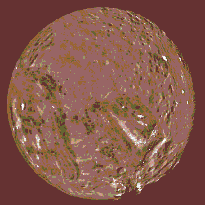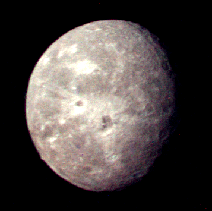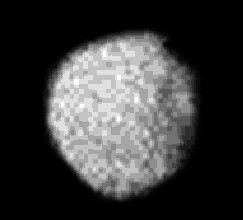This is an image of Ariel.
Click on image for full size
NASA
Ariel
Ariel was discovered by W. Lassell in 1851. It has a standoff distance of 191,240 km. Ariel is about as wide as the Oregon coast line, being 1160 km (775 miles) in size.
The surface of Ariel is hard to see in this image, but suggests that Ariel may be one of the icy moons.
You might also be interested in:

Icy moons are large or small moons which are mostly made of ice. These moons are unlike the earth's moon, which is made of silicate rock. Perfect examples of icy moons are 3 of the Galilean satellites,
...more
Uranus has // Call the moon count function defined in the document head print_moon_count('uranus'); fascinating moons and a complicated ring system. The ring is a completely different form of ring than
...more
Miranda was discovered by G. Kuiper in 1948. It has a standoff distance of 129,780 km. Miranda one of the smallest icy moons, and is as wide as the distance from Los Angeles to San Francisco, being 47
...more
The surface of Miranda is very unusual. It is not like any other moon in the solar system. Miranda has many craters but also very big grooves. These indicate that there has been activity inside Miranda
...more
Oberon was discovered by W. Herschel in 1787. It has a standoff distance of 582,600 km. Oberon is about as wide as the state of California is long, being 1520 km (1013 miles) in size. The surface features
...more
The surface of Oberon is like many icy moons. It appears to be changed for it does not have many craters. Instead it has grooves and ridges similar to those found on Ganymede. These grooves ex tend for
...more
The surface of Oberon is like many icy moons. It appears to be changed for it does not have many craters. Instead it has grooves and ridges similar to those found on Ganymede. These grooves ex tend for
...more
Puck was discovered by Voyager 2 in 1986. It has a standoff distance of 86,010 km. Puck is one of the small moons, and is about as wide as a county at 150 km (100 miles) long. As a small moon, the composition
...more











